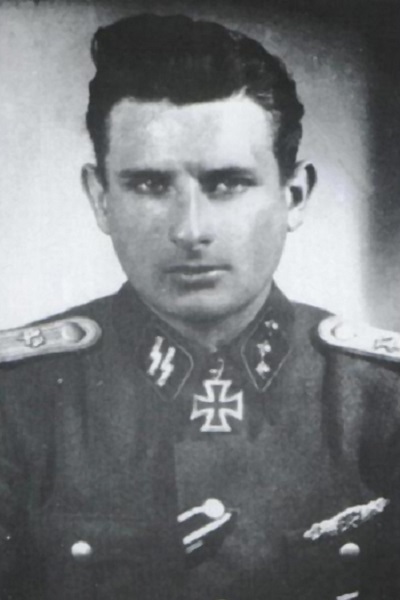Gillis, Léon (Waffen SS)
- Date of birth:
- December 11th, 1913 (Gourdinne, Belgium)
- Date of death:
- March 24th, 1977 (Vorst, Belgium)
- Service number:
- SS-Nr.: // NSDAP-Nr.:
- Nationality:
- Belgian (1830-present, Constitutional Monarchy)
Biography
00.08.1941: Schütze, 1. Kompanie, Legion 'Wallonie'
20.12.1941: promoted to Gefreiter
01.03.1942: promoted to Obergefreiter
24.08.1942: severely WIA to the lungs near Kharkov and sent to a Lazarett in Majkop
00.11.1942: sent to a Lazarett in Lemberg
00.12.1942: transferred to Lazarett Schrobenhausen then in Brussels
00.10.1943- 00.03.1944: SS-Hauptscharführer, Zugführer, II. Zug, 5. Kompanie, SS-Sturmbrigade 'Wallonien'
01.03.1944: promoted SS-Standartenoberjunker for bravery during the fighting near Cherkassy, Ukraine
20.04.1944: promoted to SS-Untersturmführer
00.08.1944: Führer, Panzerjägerzug, 5. SS-Freiwilligen-Sturmbrigade 'Wallonien' - destroyed between 14 and 19 Russian T-34 tanks
09.11.1944: promoted to SS-Obersturmführer
30.11.1944: awarded the RK by Léon Degrelle in Gronau
00.12.1944: Führer, PAK-Kompanie, SS-Panzerjäger-Abteilung 28
00.03.1945-00.04.1945: Führer, 3. Kompanie, Kampfgruppe 'Derricks'
03.05.1945: captured by the US troops - US POW
Do you have more information about this person? Inform us!
- Period:
- Second World War (1939-1945)
- Rank:
- Schütze (Private/Rifleman)
- Unit:
- 1. Kompanie, Legion 'Wallonie'
- Awarded on:
- 1941
- Period:
- Second World War (1939-1945)
- Rank:
- Gefreiter (Lance Corporal)
- Unit:
- 1. Kompanie, Legion 'Wallonie'
- Awarded on:
- 1942
- Period:
- Second World War (1939-1945)
- Rank:
- Obergefreiter (Corporal)
- Unit:
- 1. Kompanie, Legion 'Wallonie'
- Awarded on:
- March 2nd, 1942
- Period:
- Second World War (1939-1945)
- Rank:
- SS-Hauptscharführer (Sergeant Major)
- Unit:
- Zugführer, Panzerjäger-Zug, 5. SS-Freiwilligen-Sturmbrigade 'Wallonien'
- Awarded on:
- August 1942
- Period:
- Second World War (1939-1945)
- Rank:
- SS-Hauptscharführer (Sergeant Major)
- Awarded on:
- August 1942
- Period:
- Second World War (1939-1945)
- Rank:
- SS-Hauptscharführer (Sergeant Major)
- Unit:
- Zugführer, Panzerjäger-Zug, 5. SS-Freiwilligen-Sturmbrigade 'Wallonien'
- Awarded on:
- August 26th, 1942
- Period:
- Second World War (1939-1945)
- Rank:
- SS-Hauptscharführer (Sergeant Major)
- Awarded on:
- 1943
- Period:
- Second World War (1939-1945)
- Awarded on:
- 1943
- Period:
- Second World War (1939-1945)
- Rank:
- SS-Untersturmführer (2nd Lieutenant)
- Awarded on:
- 1944
- Period:
- Second World War (1939-1945)
- Rank:
- SS-Untersturmführer (2nd Lieutenant)
- Unit:
- Zugführer, 5. SS-Freiwilligen-Sturm-Brigade "Wallonie"
- Awarded on:
- September 30th, 1944
“As far back as 1941 Léon Gillis volunteered to join the Wehrmacht and repeatedly distinguished himself through notable bravery. He participated in the fighting at the Donez, Don and Caucasus mountains. Due to his bravery before the enemy he was promoted to the officer level. He particularly distinguished himself during the fighting around Tcheriakov, where the Legion SS ‘Wallonie’ offered heroic resistance in the face of overwhelming Soviet forces over the course of six days and nights. Here Gillis was badly injured: two shell splinters tore into his lungs. He hung between life and death for a long time, and required 13 months of hospital care before he was discharged. However the shell splinters could not be removed.
Right after his recovery he took over a Pak-Zug in the SS-Freiwilligen Sturmbrigade ‘Wallonien’.
In the battle of Dorpat he fought with bravery beyond compare. From the 19. to the 22.08.1944 he took over command of the second Kompanie, whose commander had become a casualty. In bitter close combat he threw the Soviets back repeatedly near Kambja.
Along with his Pak-Zug he was ordered to march towards Noo on the 22.08.1944, with his mission being to help secure the Riga—Dorpat road. On the night of the 22./23.08.1944 the Soviets bypassed this position and began their thrust back up the road about 10 kilometres further north (near Lemmatsi). The troops in Noo were thus as good as cut-off. After extremely heavy fighting, and while enduring incessant counterthrusts, Gillis succeeded in leading back two of his Pak guns to safety (the third was destroyed by a direct hit).
Meanwhile the enemy had advanced into the Emajogi bight, and they tried to cross the river northwest of Dorpat. Their group was reinforced with 10 IS-2s. The Estonian troops located there fell back. Thus, almost all alone, Gillis found himself in position at the Voora bridge with his two Pak guns as the 10 IS-2 tanks approached at around 14:00. Our Pak opened fire. Gillis personally led one gun, and with great cold-bloodedness he allowed one enemy tank to approach to a range of 30 metres. Then he sent it up into the air with a shot. A second shot: direct hit on the second tank! Yet in this very moment a direct hit destroyed Gillis’s gun. He was thrown to the ground by the blast in a badly wounded state, he had lost his eyesight.
But, with almost superhuman energy, he then took over the fire control of the second gun, which commenced such effective fire that the Soviet tanks were compelled to pull back. But even then he did not allow himself to be brought back to the main dressing station, instead awaiting the message: the enemy was in full flight.
Gillis has shown repeatedly demonstrated bravery, exemplary leadership and sacrificial devotion. With these he dedicated himself to his duty up until the tragic fate that befell him on the 23.08.1944 (no-one can say whether he will ever regain his sight). I thus recommend him for the award of the Knight’s Cross to the Iron Cross.”
Sources
- Photo 1: Igor Poul
- - Microfilm Publication A3343. US National Archives.












